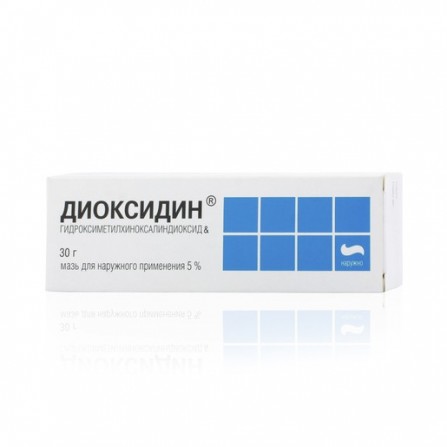More info
Active ingredients
Hydroxymethylquinoxalinedioxide
Release form
Ointment
Composition
Hydroxymethylquinoxalinedioxide 50 mg.
Pharmacological effect
2, 3-bis- (hydroxymethyl) quinoxaline 1,4-di-N-oxide. Antibacterial bactericidal drug of a broad spectrum of activity. It is active against Proteus vulgaris, Pseudomonas aeruginosa, Friedlander sticks, Escherichia coli Affects bacteria strains resistant to other antimicrobial drugs, including antibiotics. It has no irritating effect. The development of drug resistance of bacteria is possible. When administered intravenously, it is characterized by a low therapeutic breadth, therefore strict adherence to the recommended doses is necessary. Treatment of burns and purulent-necrotic wounds contributes to a more rapid cleansing of the wound surface, stimulates reparative regeneration and regional epithelialization and favorably affects the course of the wound process. In experimental studies, the presence of teratogenic, embryotoxic and mutagenic action was demonstrated.
Pharmacokinetics
After intravenous administration, the therapeutic concentration in the blood lasts 4–6 hours. The time to reach Cmax in the blood is 1–2 hours after a single injection. Well and quickly penetrates into all organs and tissues, excreted by the kidneys. With repeated injections does not accumulate.
Indications
For iv administration: - septic conditions (including in patients with burn disease); - purulent meningitis; - purulent-inflammatory processes with generalization symptoms. For intracavitary administration - purulent processes in the chest and abdominal cavity, including .: - purulent pleurisy; - pleural empyema; - peritonitis; - cystitis; - gallbladder empyema; - prevention of infectious complications after bladder catheterization. For external, local use: - wound and burn infection (superficial and deep purulent wounds of various localization, not long healing wounds and trophic ulcers, phlegmon soft tissues, infected burns, purulent wounds with osteomyelitis) - wound with the presence of deep purulent cavities (lung abscess, soft tissue abscesses, phlegmon pelvic tissue, surgical wounds of the urinary and biliary tract purulent mastitis) - pustular skin diseases.
Contraindications
- hypersensitivity; - adrenal insufficiency (including in history); - pregnancy; - lactation period (breastfeeding); - children's age (under 18) .C caution: renal failure.
Precautionary measures
Use during pregnancy and lactation. It is contraindicated in pregnancy and lactation (breastfeeding). It is used in cases of impaired renal functionC caution: renal failure. With CRF, the dose is reduced. It is prescribed only with the ineffectiveness of other antimicrobial drugs. Use in childrenContraindicated in children and adolescents under 18 years of age.
Dosage and administration
In / in the drip. In severe septic conditions, a 0.5% solution is injected for injection, predisposing in a 5% dextrose solution or in a 0.9% solution of sodium chloride to a concentration of 0.1-0.2%. The highest single dose is 300 mg, daily 600 mg. Intrafoil. In the cavity, the solution is injected through a drainage tube, a catheter or a syringe, 10-50 ml of 1% solution. Externally, wipes moistened with 1% solution are applied daily or every other day to the wound surface, which has been cleansed of purulent necrotic masses. burn wounds and the course of the wound process. Deep wounds are padded or irrigated with a 0.5% solution. The maximum daily dose - 2.5 g. Duration of treatment - up to 3 weeks.
Side effects
Allergic reactions. After i / v and intracavitary injection - headache, chills, hyperthermia, nausea, vomiting, diarrhea, muscle twitching. Local reactions: osteoporic dermatitis.
special instructions
With CRF, the dose is reduced. Assign only with the ineffectiveness of other antimicrobial drugs.





